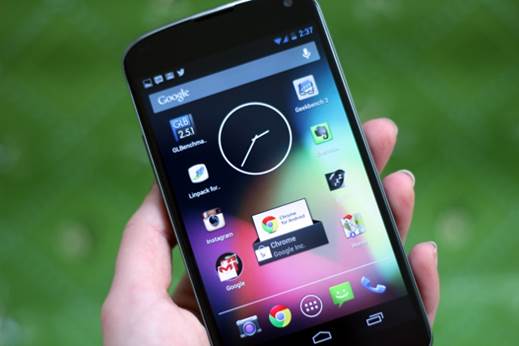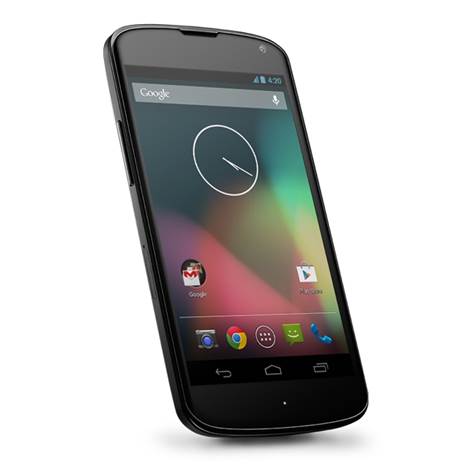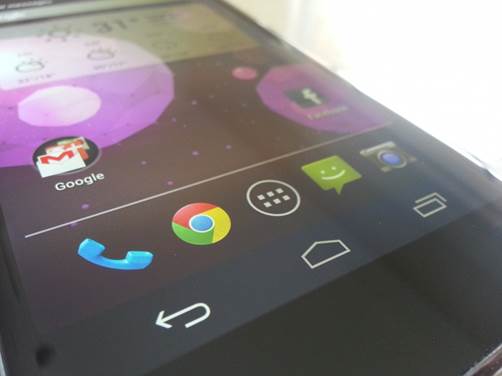Android 4.2
Besides the first ever Nexus (made by Nexus
One do HTC), each of the next versions of Nexus opens a new era of Android firmware
together with it – Gingerbread for Nexus S, Honeycomb for Motorola XOOM, ICS on
Galaxy Nexus and Jelly Bean on Nexus 7. And as we have expected from this
antecedent, Nexus 4 is preloaded with Android 4.2. But this time there’s
something so different: regardless on the number of the new versions, is
upgrade is still considered as Jelly Bean. This is the first time we see a move
like that ever since Éclair increases from 2.0 to 2.1. An incremental “.X” upgrade
without having the new code named after the dessert theme which normally
indicates a new refresh with only some small innovation. We think that there’s
enough change to excuse for jumping up to a party starting “K”, but most
changes in important designs are all related to the tablet experience; on the
contrary, there’re just a few noticeable changes on the phone. We wonder if
many features that are added to Nexus 4 and Nexus 10 have appeared on the
drawing along with the remains of Jelly Bean but are not ready in time, but
this is not important. The important thing is that we have something fresh and
new to enjoy at this time. Here is what you can see on Jelly Bean, for the next
part.

Besides
the first ever Nexus (made by Nexus One do HTC), each of the next versions of
Nexus opens a new era of Android firmware
First, we have mentioned shortly that you
will see a huge difference about the tablet more than about the phone. This is
because Nexus 10 abandons the settings box at the bottom right corner and menu
app access at the top right corner. Instead of that, it provides 2 pull-down menus
on the top: the left side acts as a standard notification menu, while the right
side has the new Quick Settings menu. It also uses the standard 3-virtual
notification buttons that you will see on Nexus 7 and Galaxy Nexus.

Nexus
4 with Android 4.2
Finally, Android 4.2 also bring the
multiuser capability to the tablet, in which the different members of the
family can have their own set of apps, file in other words, the same experience
as you have on standard PC or Mac. Unfortunately, it’s not available for smartphone,
so Nexus 4 can’t take advantages of this thing. (We have feelings that this
feature is added to the phone at some time, but we don’t have the source of
internal info to confirm this). Let’s dig deeper to the innovations that you
can use on Nexus 4. Quick Settings menu are what its name implies – a panel full
of access point such as brightness, Wi-Fi, battery life, airplane mode,
Bluetooth and data using. It also includes the direct link to the settings menu.
The conception is extremely alike to what you will find on TouchWiz or LG devices
but it uses the private space instead of living on the same menu as the
notifications. Luckily, it’s easy to approach: drag down from the status bar
with 2 fingers instead of 1, and you’re there fast. It can be access from the Lock
Screen and notification menu. Sound familiar? If it is so, that may be because
you can find an incredibly similar conception in the newest device series of Motorola,
such as RAZR M and RAZR HD. Based on the new role of Moto, it definitely seems
like a very accidental but interesting coincidence, doesn’t it?

Android
4.2 also bring the multiuser capability to the tablet, in which the different
members of the family can have their own set of apps, file
The new and improved Jelly Bean also has
natural feature support on Lock Screen and even provides a lot of panel for the
additional utilities. Our checked phones don’t come with this feature, because
it’s not available until the Nexus devices start to be on sale, but his can be
one of our favorite additions for Android. We love the idea of being able to
see the email, work appointments and other notifications without entering the
home screen – it may sound like we’re too lazy to take another step and open
the screen to see the utility, but the ability to have a quick view over
important info without entering the phone shouldn’t be underestimated. You may
expect to see more cards appear in Google Now. The service has been granted
with more power, such as the ability to look for local events and concerts, the
attractive points nearby and Photo Spots. Card for Photo Spots presents a thumbnail
grid (small images), each of which can be clicked to have bigger images,
details and instructions. There’s a new bunch of cards scouring into your Gmail
inbox and looking for related info: when you have flights or email for
confirming of hotel room reservation, Now will automatically take it and remind
you. The same thing applies for parcel, event and restaurant booking.